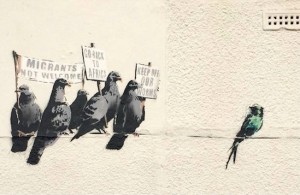Graffiti: Its History and What It’s Become
December 17, 2014

Scribbles on walls. Drawings on Subways. Graffiti has become a word associated with vandalism, delinquency, and hip-hop. However, graffiti is more than that. This misunderstood art form actually has a more sophisticated connotation and history.
History at a Glance
Graffiti originated from Ancient Greco-roman civilizations. People wrote names and poems in order to protest silently. These writings gave insight to the lifestyle and values at the time. Today, graffiti serves a similar function. With a similar style, artists Cool Earl and Cornbread started “tagging” in 1960s Philadelphia. “Tagging” was the early art movement which artists wrote their nicknames on walls and public spaces.Tagging was used to express an artist’s feelings or to attract a special somebody. Street gangs would tag to mark their territory. But ultimately, Tagging was an expression of art.
Transcending beyond name writing, graffiti has become a tool for social criticism. Artists like Bansky use graffiti to express their opinions about topics such as cultural differences, the rise of technology, and love. Their expressions to critique society have become modern day graffiti. These expressions, although connected to hip-hop culture, are not synonymous to hip-hop. The artist just happened to express his/her idea through hip-hop to reach a broader audience.
Graffiti at Hackley
On November 20th, UNITY hosted a meeting about graffiti. Students across upper school came to discuss the culture and connotations. Many students believe that art is a form of expression: Besides focusing on the discussion, the meeting allowed students to express their own sense of art by spray painting their own works. Junior Elijah Ngbokoli said that “before the meeting I used to think that graffiti was like vandalism and now its more like a way people express themselves.”
Graffiti as an Art
Banksy uses his artwork to critique the contemporary issues of society. He uses animals and children to depict political views, comments the problems of capitalism, condemn hypocrisy and greed. Banksy’s artwork changed from acts of vandalism to high priced art works. He recycles old ideas, drawing inspiration from Monet’s water lilies. From his artworks, he inspires other artists, creating the “Banksy effect”. From the artwork below, Banksy depicts the broken and intolerant immigration system. Through this depiction, he criticizes the ignorance and hypocrisy of the country’s values.
Conclusion
Becoming accepted as a form of art, graffiti’s connotation has changed from vandalism to an artist’s expression. As graffiti becomes more popular through the spread of hip-hop culture, people have started to understand the beauty of this art. Highly priced, graffiti has steered away from its previous connotations.
